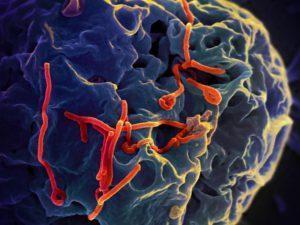The role of CD8 T cells in protective vaccine induced responses against ebola virus (EBOV) is not clearly defined. One study showed that vaccine induced CD8 T cell responses to EBOV glycoprotein (GP) are required for protection against EBV. While another study conflicted these results, showing that GP-specific CD8 T cell responses were dispensable for protection. Research conducted by Sakabe and colleagues, aimed to characterise T cell responses to EBOV proteins from 32 ebola virus diseases (EVD) survivors of the 2013-16 West African Outbreak.
EBOV-specific memory CD8+ T cells responses were determined by the ability to produce IFN-γ and/or TNF-α in response to stimulation with Recombinant vesicular stomatitis virus (rVSV) encoding EBOV nucleoprotein (NP), VP24, VP30, VP35, VP40, GP and soluble GP (sGP) proteins. This stimulation method allows innate immune responses such as endogenous processing and peptide presentation to be as similar as in vivo antigen stimulation as possible. Of the 32 EVD survivors tested, 26 had detectable EBOV-specific cytokine IFN-γ+ TNF-α+ responses. Of the 7 proteins tests for immunogenicity, majority (96%) of individuals possessed NP-reactive CD8 T cells, whereas only 38% of individuals possessed GP/sGP reactive CD8 T cells. Researchers also showed that GP- and sGP-specific CD8+ T cell responses detected predominantly responded to shared epitopes between GP and sGP.
The most advanced experimental EBOV, rsVSV-ZEBOV vaccine , that was used to vaccinate individuals in the recent EBOV Outbreak in the Democratic Republic of Congo expresses the GP antigen. In this study GP/sGP are the least immunodominant antigens in EVD survivors. This highlights the need for improved understanding in the relationship between immunodominant antigen-specific responses and protective immunity, at different stages of EBOV infection.
In summary, the study highlighted the utility of an experimental biological approach that enables detection of naturally occurring immunodominant EBOV antigen-specific CD8 T cell responses. Results from this screening, could warrant the potential inclusion of EBOV-NP to future (and current) vaccine strategies, has the potential to best mimic immune responses in survivors as well x.
Journal Article: Sakabe et al., 2018. Analysis of CD8+ T cell response during the 2013–2016 Ebola epidemic in West Africa. PNAS.
Article by Cheleka AM Mpande











